[English] 日本語
 Yorodumi
Yorodumi- PDB-8tvq: Cryo-EM structure of CPD stalled 10-subunit Pol II in complex wit... -
+ Open data
Open data
- Basic information
Basic information
| Entry | Database: PDB / ID: 8tvq | |||||||||||||||
|---|---|---|---|---|---|---|---|---|---|---|---|---|---|---|---|---|
| Title | Cryo-EM structure of CPD stalled 10-subunit Pol II in complex with Rad26 | |||||||||||||||
 Components Components |
| |||||||||||||||
 Keywords Keywords | TRANSCRIPTION/DNA/RNA /  RNA Polymerase II / Rad26 / CPD lesion / Transcription-coupled DNA repair / RNA Polymerase II / Rad26 / CPD lesion / Transcription-coupled DNA repair /  TRANSCRIPTION / TRANSCRIPTION-DNA-RNA complex TRANSCRIPTION / TRANSCRIPTION-DNA-RNA complex | |||||||||||||||
| Function / homology |  Function and homology information Function and homology informationnuclear DNA-directed RNA polymerase complex / RNA Polymerase I Transcription Initiation / Processing of Capped Intron-Containing Pre-mRNA / : / RNA Polymerase III Transcription Initiation From Type 2 Promoter / RNA Pol II CTD phosphorylation and interaction with CE / Formation of the Early Elongation Complex / mRNA Capping / Formation of TC-NER Pre-Incision Complex / RNA polymerase II transcribes snRNA genes ...nuclear DNA-directed RNA polymerase complex / RNA Polymerase I Transcription Initiation / Processing of Capped Intron-Containing Pre-mRNA / : / RNA Polymerase III Transcription Initiation From Type 2 Promoter / RNA Pol II CTD phosphorylation and interaction with CE / Formation of the Early Elongation Complex / mRNA Capping / Formation of TC-NER Pre-Incision Complex / RNA polymerase II transcribes snRNA genes / RNA Polymerase I Promoter Escape / TP53 Regulates Transcription of DNA Repair Genes / Estrogen-dependent gene expression / RNA Polymerase II Promoter Escape / RNA Polymerase II Transcription Pre-Initiation And Promoter Opening / RNA Polymerase II Transcription Initiation / RNA Polymerase II Transcription Initiation And Promoter Clearance / RNA-templated transcription / termination of RNA polymerase III transcription / RNA Polymerase II Pre-transcription Events / Dual incision in TC-NER /  RNA polymerase I activity / termination of RNA polymerase I transcription / RNA polymerase I activity / termination of RNA polymerase I transcription /  transcription initiation at RNA polymerase III promoter / tRNA transcription by RNA polymerase III / nucleolar large rRNA transcription by RNA polymerase I / Gap-filling DNA repair synthesis and ligation in TC-NER / transcription initiation at RNA polymerase III promoter / tRNA transcription by RNA polymerase III / nucleolar large rRNA transcription by RNA polymerase I / Gap-filling DNA repair synthesis and ligation in TC-NER /  transcription initiation at RNA polymerase I promoter / transcription elongation by RNA polymerase I / transcription initiation at RNA polymerase I promoter / transcription elongation by RNA polymerase I /  RNA polymerase II activity / RNA polymerase II activity /  translesion synthesis / translesion synthesis /  RNA polymerase I complex / transcription by RNA polymerase I / RNA polymerase I complex / transcription by RNA polymerase I /  RNA polymerase III complex / transcription by RNA polymerase III / RNA polymerase III complex / transcription by RNA polymerase III /  RNA polymerase II, core complex / RNA polymerase II, core complex /  DNA-directed RNA polymerase complex / transcription elongation by RNA polymerase II / DNA-directed RNA polymerase complex / transcription elongation by RNA polymerase II /  transcription initiation at RNA polymerase II promoter / transcription initiation at RNA polymerase II promoter /  ribonucleoside binding / DNA-directed 5'-3' RNA polymerase activity / ribonucleoside binding / DNA-directed 5'-3' RNA polymerase activity /  DNA-directed RNA polymerase / cytoplasmic stress granule / DNA-directed RNA polymerase / cytoplasmic stress granule /  ribosome biogenesis / transcription by RNA polymerase II / ribosome biogenesis / transcription by RNA polymerase II /  nucleic acid binding / nucleic acid binding /  protein dimerization activity / DNA-templated transcription / protein dimerization activity / DNA-templated transcription /  nucleolus / nucleolus /  mitochondrion / mitochondrion /  DNA binding / zinc ion binding / DNA binding / zinc ion binding /  nucleoplasm / nucleoplasm /  metal ion binding / metal ion binding /  nucleus / nucleus /  cytoplasm cytoplasmSimilarity search - Function | |||||||||||||||
| Biological species |   Saccharomyces cerevisiae (brewer's yeast) Saccharomyces cerevisiae (brewer's yeast)synthetic construct (others) | |||||||||||||||
| Method |  ELECTRON MICROSCOPY / ELECTRON MICROSCOPY /  single particle reconstruction / single particle reconstruction /  cryo EM / Resolution: 4.6 Å cryo EM / Resolution: 4.6 Å | |||||||||||||||
 Authors Authors | Sarsam, R.D. / Lahiri, I. / Leschziner, A.E. | |||||||||||||||
| Funding support |  United States, 4items United States, 4items
| |||||||||||||||
 Citation Citation |  Journal: Proc Natl Acad Sci U S A / Year: 2024 Journal: Proc Natl Acad Sci U S A / Year: 2024Title: Elf1 promotes Rad26's interaction with lesion-arrested Pol II for transcription-coupled repair. Authors: Reta D Sarsam / Jun Xu / Indrajit Lahiri / Wenzhi Gong / Qingrong Li / Juntaek Oh / Zhen Zhou / Peini Hou / Jenny Chong / Nan Hao / Shisheng Li / Dong Wang / Andres E Leschziner /  Abstract: Transcription-coupled nucleotide excision repair (TC-NER) is a highly conserved DNA repair pathway that removes bulky lesions in the transcribed genome. Cockayne syndrome B protein (CSB), or its ...Transcription-coupled nucleotide excision repair (TC-NER) is a highly conserved DNA repair pathway that removes bulky lesions in the transcribed genome. Cockayne syndrome B protein (CSB), or its yeast ortholog Rad26, has been known for decades to play important roles in the lesion-recognition steps of TC-NER. Another conserved protein ELOF1, or its yeast ortholog Elf1, was recently identified as a core transcription-coupled repair factor. How Rad26 distinguishes between RNA polymerase II (Pol II) stalled at a DNA lesion or other obstacles and what role Elf1 plays in this process remains unknown. Here, we present cryo-EM structures of Pol II-Rad26 complexes stalled at different obstacles that show that Rad26 uses a common mechanism to recognize a stalled Pol II, with additional interactions when Pol II is arrested at a lesion. A cryo-EM structure of lesion-arrested Pol II-Rad26 bound to Elf1 revealed that Elf1 induces further interactions between Rad26 and a lesion-arrested Pol II. Biochemical and genetic data support the importance of the interplay between Elf1 and Rad26 in TC-NER initiation. Together, our results provide important mechanistic insights into how two conserved transcription-coupled repair factors, Rad26/CSB and Elf1/ELOF1, work together at the initial lesion recognition steps of transcription-coupled repair. | |||||||||||||||
| History |
|
- Structure visualization
Structure visualization
| Structure viewer | Molecule:  Molmil Molmil Jmol/JSmol Jmol/JSmol |
|---|
- Downloads & links
Downloads & links
- Download
Download
| PDBx/mmCIF format |  8tvq.cif.gz 8tvq.cif.gz | 1.2 MB | Display |  PDBx/mmCIF format PDBx/mmCIF format |
|---|---|---|---|---|
| PDB format |  pdb8tvq.ent.gz pdb8tvq.ent.gz | 1002.5 KB | Display |  PDB format PDB format |
| PDBx/mmJSON format |  8tvq.json.gz 8tvq.json.gz | Tree view |  PDBx/mmJSON format PDBx/mmJSON format | |
| Others |  Other downloads Other downloads |
-Validation report
| Arichive directory |  https://data.pdbj.org/pub/pdb/validation_reports/tv/8tvq https://data.pdbj.org/pub/pdb/validation_reports/tv/8tvq ftp://data.pdbj.org/pub/pdb/validation_reports/tv/8tvq ftp://data.pdbj.org/pub/pdb/validation_reports/tv/8tvq | HTTPS FTP |
|---|
-Related structure data
| Related structure data |  41648MC 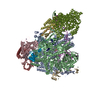 8tugC 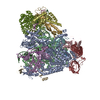 8tvpC 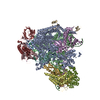 8tvsC 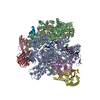 8tvvC 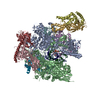 8tvwC 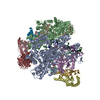 8tvxC 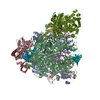 8tvyC M: map data used to model this data C: citing same article ( |
|---|---|
| Similar structure data | Similarity search - Function & homology  F&H Search F&H Search |
- Links
Links
- Assembly
Assembly
| Deposited unit | 
|
|---|---|
| 1 |
|
- Components
Components
-DNA-directed RNA polymerase II subunit ... , 4 types, 4 molecules ACIK
| #1: Protein |  Polymerase / RNA polymerase II subunit 1 / RNA polymerase II subunit B1 / DNA-directed RNA polymerase III ...RNA polymerase II subunit 1 / RNA polymerase II subunit B1 / DNA-directed RNA polymerase III largest subunit / RNA polymerase II subunit B220 Polymerase / RNA polymerase II subunit 1 / RNA polymerase II subunit B1 / DNA-directed RNA polymerase III ...RNA polymerase II subunit 1 / RNA polymerase II subunit B1 / DNA-directed RNA polymerase III largest subunit / RNA polymerase II subunit B220Mass: 191821.578 Da / Num. of mol.: 1 / Source method: isolated from a natural source / Source: (natural)   Saccharomyces cerevisiae (brewer's yeast) / References: UniProt: P04050, Saccharomyces cerevisiae (brewer's yeast) / References: UniProt: P04050,  DNA-directed RNA polymerase DNA-directed RNA polymerase |
|---|---|
| #3: Protein |  Polymerase PolymeraseMass: 35330.457 Da / Num. of mol.: 1 / Source method: isolated from a natural source / Source: (natural)   Saccharomyces cerevisiae (brewer's yeast) / References: UniProt: A0A6A5Q0Z3 Saccharomyces cerevisiae (brewer's yeast) / References: UniProt: A0A6A5Q0Z3 |
| #7: Protein |  Polymerase PolymeraseMass: 14308.161 Da / Num. of mol.: 1 / Source method: isolated from a natural source / Source: (natural)   Saccharomyces cerevisiae (brewer's yeast) / References: UniProt: A0A7I9EWC2 Saccharomyces cerevisiae (brewer's yeast) / References: UniProt: A0A7I9EWC2 |
| #9: Protein |  Polymerase PolymeraseMass: 13633.493 Da / Num. of mol.: 1 / Source method: isolated from a natural source / Source: (natural)   Saccharomyces cerevisiae (brewer's yeast) / References: UniProt: A0A6A5Q7A1 Saccharomyces cerevisiae (brewer's yeast) / References: UniProt: A0A6A5Q7A1 |
-Protein , 2 types, 2 molecules BM
| #2: Protein |  Polymerase PolymeraseMass: 138937.297 Da / Num. of mol.: 1 / Source method: isolated from a natural source / Source: (natural)   Saccharomyces cerevisiae (brewer's yeast) Saccharomyces cerevisiae (brewer's yeast)References: UniProt: A0A6A5Q4H2,  DNA-directed RNA polymerase DNA-directed RNA polymerase |
|---|---|
| #11: Protein | Mass: 36953.504 Da / Num. of mol.: 1 Source method: isolated from a genetically manipulated source Source: (gene. exp.)   Saccharomyces cerevisiae (brewer's yeast) Saccharomyces cerevisiae (brewer's yeast)Production host:   Escherichia coli (E. coli) Escherichia coli (E. coli) |
-DNA-directed RNA polymerases I, II, and III subunit ... , 3 types, 3 molecules EFH
| #4: Protein |  RNA polymerase RNA polymeraseMass: 25117.094 Da / Num. of mol.: 1 / Source method: isolated from a natural source / Source: (natural)   Saccharomyces cerevisiae (brewer's yeast) / References: UniProt: A0A6A5Q456 Saccharomyces cerevisiae (brewer's yeast) / References: UniProt: A0A6A5Q456 |
|---|---|
| #5: Protein |  RNA polymerase RNA polymeraseMass: 17931.834 Da / Num. of mol.: 1 / Source method: isolated from a natural source / Source: (natural)   Saccharomyces cerevisiae (brewer's yeast) / References: UniProt: P20435 Saccharomyces cerevisiae (brewer's yeast) / References: UniProt: P20435 |
| #6: Protein |  RNA polymerase RNA polymeraseMass: 16525.363 Da / Num. of mol.: 1 / Source method: isolated from a natural source / Source: (natural)   Saccharomyces cerevisiae (brewer's yeast) / References: UniProt: A0A6A5Q8C2 Saccharomyces cerevisiae (brewer's yeast) / References: UniProt: A0A6A5Q8C2 |
-DNA-directed RNA polymerases II subunit ... , 2 types, 2 molecules JL
| #8: Protein |  RNA polymerase RNA polymeraseMass: 8290.732 Da / Num. of mol.: 1 / Source method: isolated from a natural source / Source: (natural)   Saccharomyces cerevisiae (brewer's yeast) / References: UniProt: A0A6A5Q7Q6 Saccharomyces cerevisiae (brewer's yeast) / References: UniProt: A0A6A5Q7Q6 |
|---|---|
| #10: Protein |  RNA polymerase RNA polymeraseMass: 7729.969 Da / Num. of mol.: 1 / Source method: isolated from a natural source / Source: (natural)   Saccharomyces cerevisiae (brewer's yeast) / References: UniProt: A0A6A5PY05 Saccharomyces cerevisiae (brewer's yeast) / References: UniProt: A0A6A5PY05 |
-DNA chain , 2 types, 2 molecules NT
| #12: DNA chain | Mass: 14494.314 Da / Num. of mol.: 1 / Source method: obtained synthetically / Source: (synth.) synthetic construct (others) |
|---|---|
| #13: DNA chain | Mass: 14275.127 Da / Num. of mol.: 1 / Source method: obtained synthetically / Source: (synth.) synthetic construct (others) |
-RNA chain , 1 types, 1 molecules R
| #14: RNA chain |  Mass: 3264.036 Da / Num. of mol.: 1 / Source method: obtained synthetically / Source: (synth.) synthetic construct (others) |
|---|
-Non-polymers , 2 types, 9 molecules 


| #15: Chemical | ChemComp-ZN / #16: Chemical | ChemComp-MG / | |
|---|
-Details
| Has ligand of interest | N |
|---|
-Experimental details
-Experiment
| Experiment | Method:  ELECTRON MICROSCOPY ELECTRON MICROSCOPY |
|---|---|
| EM experiment | Aggregation state: PARTICLE / 3D reconstruction method:  single particle reconstruction single particle reconstruction |
- Sample preparation
Sample preparation
| Component | Name: Cryo-EM structure of CPD lesion containing 10 subunit RNA Polymerase II elongation complex with Rad26 Type: COMPLEX / Entity ID: #1-#14 / Source: MULTIPLE SOURCES |
|---|---|
| Source (natural) | Organism:   Saccharomyces cerevisiae (brewer's yeast) Saccharomyces cerevisiae (brewer's yeast) |
| Buffer solution | pH: 7.4 |
| Specimen | Embedding applied: NO / Shadowing applied: NO / Staining applied : NO / Vitrification applied : NO / Vitrification applied : YES : YES |
Vitrification | Cryogen name: ETHANE |
- Electron microscopy imaging
Electron microscopy imaging
| Experimental equipment |  Model: Talos Arctica / Image courtesy: FEI Company |
|---|---|
| Microscopy | Model: FEI TALOS ARCTICA |
| Electron gun | Electron source : :  FIELD EMISSION GUN / Accelerating voltage: 200 kV / Illumination mode: FLOOD BEAM FIELD EMISSION GUN / Accelerating voltage: 200 kV / Illumination mode: FLOOD BEAM |
| Electron lens | Mode: BRIGHT FIELD Bright-field microscopy / Nominal defocus max: 2500 nm / Nominal defocus min: 600 nm Bright-field microscopy / Nominal defocus max: 2500 nm / Nominal defocus min: 600 nm |
| Image recording | Electron dose: 52 e/Å2 / Film or detector model: GATAN K2 SUMMIT (4k x 4k) |
- Processing
Processing
CTF correction | Type: PHASE FLIPPING AND AMPLITUDE CORRECTION | ||||||||||||||||||||||||
|---|---|---|---|---|---|---|---|---|---|---|---|---|---|---|---|---|---|---|---|---|---|---|---|---|---|
3D reconstruction | Resolution: 4.6 Å / Resolution method: FSC 0.143 CUT-OFF / Num. of particles: 22000 / Symmetry type: POINT | ||||||||||||||||||||||||
| Refine LS restraints |
|
 Movie
Movie Controller
Controller









 PDBj
PDBj










































